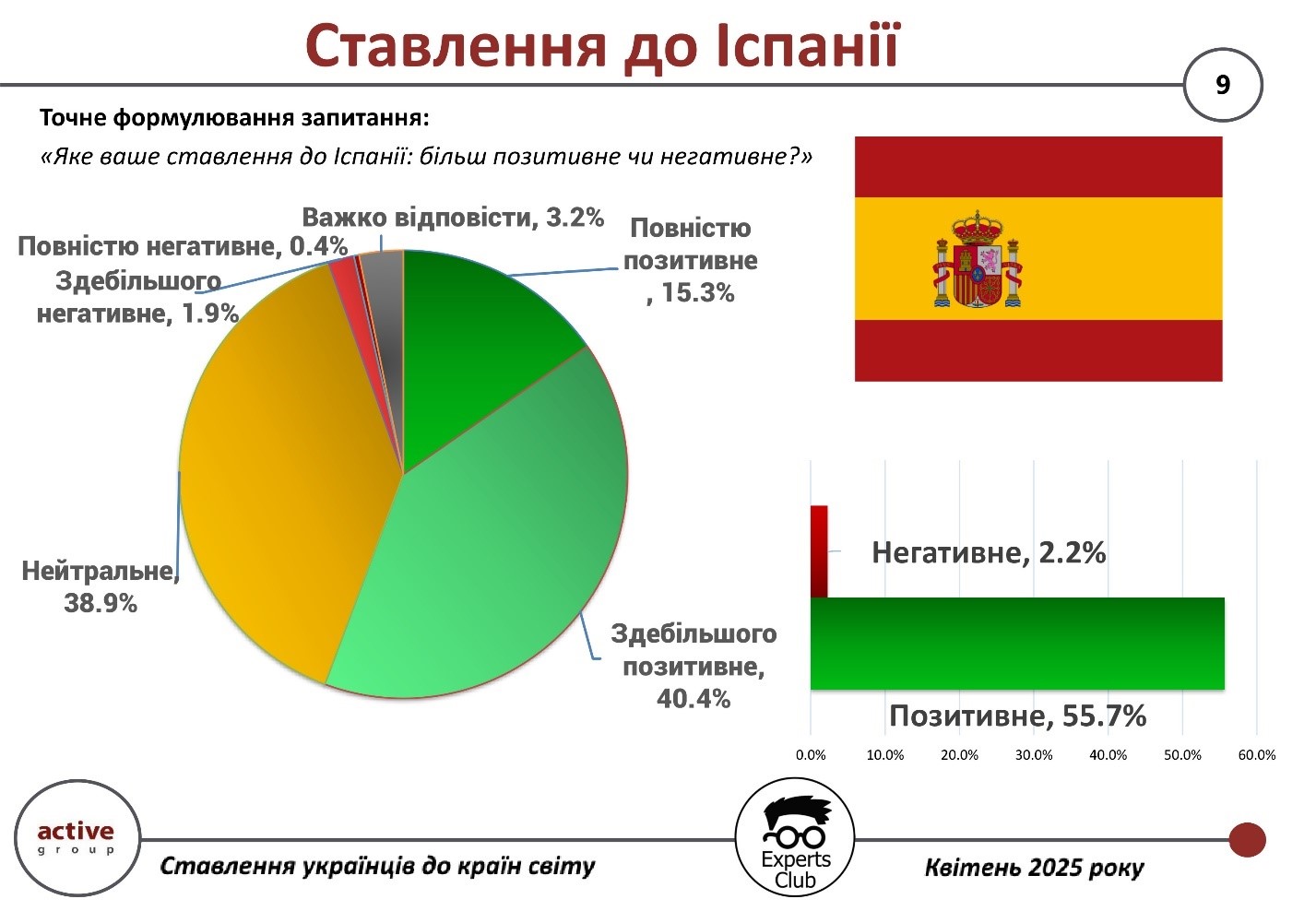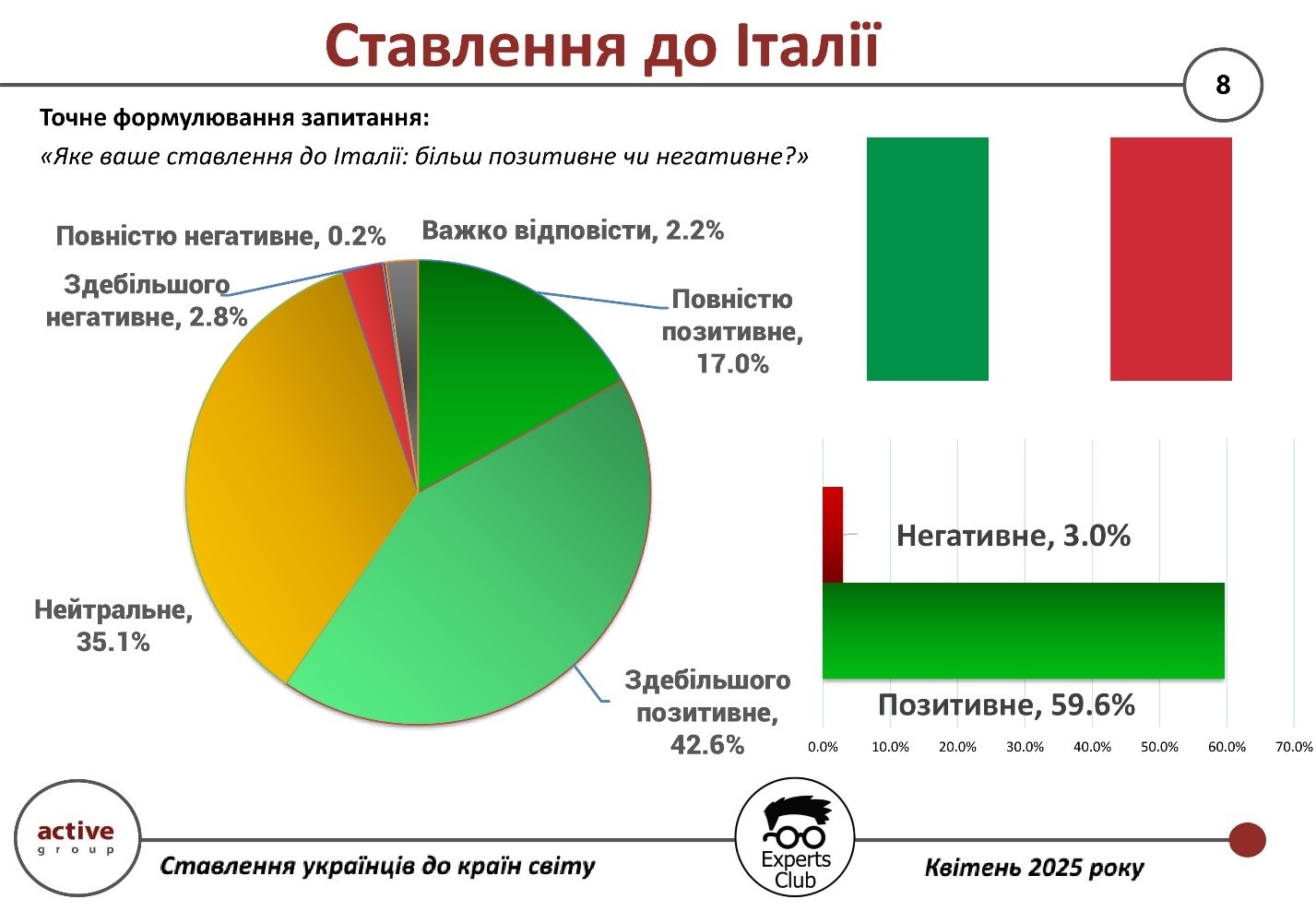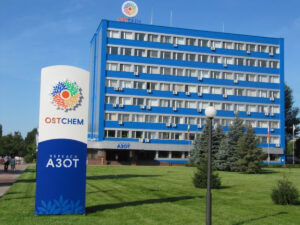
Spain received a predominantly positive assessment from Ukrainians, but the results also indicate a significant proportion of neutral perceptions. These conclusions are contained in the data of a sociological survey conducted by Active Group together with the Experts Club analytical center in April 2025.
According to the results, 55.7% of respondents have a positive attitude toward Spain (40.4% — mostly positive, 15.3% — completely positive). Only 2.2% of respondents expressed a negative attitude (1.9% mostly negative, 0.4% completely negative), while the largest share, 38.9%, took a neutral position. Another 3.2% were undecided.

“Spain has a good image in the minds of our citizens, but unlike countries with consistent foreign policy activity towards Ukraine, its support is perceived less clearly. This explains the high level of neutral assessments,” commented Alexander Pozniy, co-founder of Active Group.
The poll shows that even against a positive backdrop, Ukrainians are carefully analyzing the degree of real involvement of international partners in deciding the fate of their country.
The presentation of the study is available at the link.
ACTIVE GROUP, DIPLOMACY, EXPERTS CLUB, Pozniy, SOCIOLOGY, URAKIN

Italy is among the countries that Ukrainians treat with respect and sympathy, but at the same time they are cautious. These data were obtained during a sociological survey conducted by Active Group in collaboration with Experts Club in April 2025.
According to the results, 59.6% of respondents have a positive perception of Italy (42.6% — mostly positive, 17% — completely positive). Only 3% of Ukrainians expressed a negative attitude (2.8% mostly negative, 0.2% completely negative), while a significant proportion — 35.1% — chose a neutral position. Another 2.2% were unable to answer.

“Italy remains in the minds of Ukrainians as a country of traditional culture, historical monuments, and hospitality. At the same time, the relatively high proportion of neutral assessments indicates Italy’s lack of activity in the political or humanitarian sphere compared to other partners,” explained Maxim Urakin, founder of Experts Club.
The study shows that in order to deepen the positive image in Ukrainian society, it is important not only to have a good image, but also to provide concrete support at critical moments.
The presentation of the study is available at the link.
ACTIVE GROUP, DIPLOMACY, EXPERTS CLUB, Pozniy, SOCIOLOGY, URAKIN

In April 2025, Ukraine doubled its electricity exports compared to March, reaching 151.6 thousand MWh, while imports fell by almost a third to 187 thousand MWh, according to the Ukrainian energy and climate think tank DiXi Group, citing Energy Map.
As explained by DiXi Group experts on the center’s Facebook page, at the beginning of the month, electricity consumption increased due to lower air temperatures, in particular due to additional heating needs. However, in the second half of April, stable weather conditions – warmer and sunny weather – reduced the load on the power grid and contributed to an increase in exports.
Of the 151.6 thousand MWh, 38% (57.1 thousand MWh) went to Hungary, 35% (52.8 thousand MWh) to Moldova, 15% (23.3 thousand MWh) to Romania, 12% (18.4 thousand MWh) to Slovakia. Supplies to Poland have been suspended since mid-March.
Compared to April 2024, exports increased 12.6 times: at that time, they amounted to only 12 thousand MWh.
The distribution of 187,000 MWh of electricity imports by country is as follows: 45% (83,100 MWh) came from Hungary, 18% (34,200 MWh) from Slovakia, 18% (34.2 thousand MWh) from Poland, 13% (24.5 thousand MWh) from Romania, and 6% (11 thousand MWh) from Moldova.
Compared to April 2024 (223.8 thousand MWh), imports decreased by 16%.
“Despite the growth in exports, the total volume of imports in April still exceeds exports by 19%,” DiXi Group experts note.
As reported, Ukraine increased electricity exports by 131% in March to 76.3 thousand MWh, while imports increased by 11% to 272.3 thousand MWh.

In January-March 2025, the nitrogen holding Ostchem produced 529.3 thousand tons of mineral fertilizers, which is 26.5 thousand tons, or 5.3% more than in the same period of 2023.
“The production structure changed in line with demand and imports: the share of ammonium nitrate and urea decreased, while the share of the most popular type of fertilizer, UAN (urea ammonium nitrate), increased,” the holding said in a statement on Thursday.
Ammonia nitrate production in the first quarter of 2025 decreased to 226,500 tons from 246,000 tons last year, urea to 116,700 tons from 123,500 tons, while UAN production increased from 123,800 to 162.2 thousand tons, and VAS (lime-ammonium nitrate, which is produced only at Rivneazot) – to 15.8 thousand tons from 10.8 thousand tons.
In total, Cherkasy Azot produced 394.8 thousand tons of products, and Rivneazot produced 134.4 thousand tons.
“Ostchem enterprises faced forced production stoppages due to drones entering the territory of our plants and the destruction of external gas and energy infrastructure in the Cherkasy and Rivne regions. Force majeure led to forced disruptions in fertilizer supplies, so we apologize to our customers,” the release said, citing Group DF’s head of corporate communications, Oleg Arestarkhov.
According to him, this was the most difficult season because the holding suffered huge losses due to emergency shutdowns and restarts of production facilities, but he confirmed that fertilizer orders would be fulfilled.
He also thanked the staff of the State Emergency Service of Ukraine for their help in extinguishing the fires, as well as others involved in restoring the destroyed energy and gas infrastructure.
The release also notes that the Ostchem nitrogen holding company revised its strategy in 2025: the new priority is to reduce production risks through investments in the energy independence of enterprises.
“With rising electricity prices and continuing risks, the nitrogen business is forced to take steps to ensure the stability of production chains and reduce external energy consumption,” the holding company explains.
Ostchem is Dmitry Firtash’s Group DF nitrogen holding company, which brings together the largest mineral fertilizer producers in Ukraine. Since 2011, it has included Rivneazot and Cherkasy Azot, as well as Severodonetsk Azot and Stirol, which are not operating and are located in the occupied territories.
Cherkasy Azot (Cherkasy, Ukraine) is one of Ukraine’s largest chemical companies. Its designed production capacity is 962,700 tons of ammonia per year, 970,000 tons of ammonium nitrate per year, 891,600 tons of urea per year, and 1 million tons of UAN per year.
PJSC Rivneazot is one of the largest chemical companies in Western Ukraine. On April 12, 2024, Group DF and South Korea’s Hyundai Engineering signed an agreement to build a chemical hub in Rivne. The project involves the construction of plants for the production of green ammonia and hydrogen based on renewable energy sources, as well as new enterprises and production sites for the production of nitrogen fertilizers and chemical derivatives.
Geographical structure of Ukraine’s foreign trade (surplus) in January-December 2024, million USD
